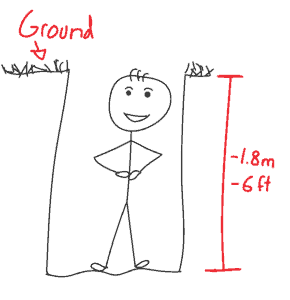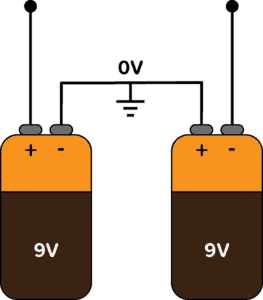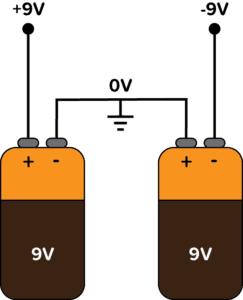I’m going to show you what negative voltage is by putting John into a hole. As you’ll quickly learn, it’s nothing weird or mystical.
Meet John. He is 1.8 meters (6 feet) tall.

What does it mean that John is 1.8 m tall? Could you find his height by only looking at his head?
No. You have to compare the top of his head to the ground he is standing on to be able to find his height. That John is 1.8 m tall really means that the top of his head is 1.8 m higher than the ground that he stands on.
It’s the same thing with voltage. You can’t say anything about the voltage without comparing it to another point.
It’s common to define a zero point (0V), or ground, in a circuit.
In a simple battery circuit, the ground point is usually the minus terminal of the battery. So if someone says that “this point is 5V”, they usually mean it’s 5V compared to ground.
Putting John in a Hole
Back to John. What if we dig a hole of 1.8 meters, then put John into the hole. (Poor John).

10 Simple Steps to Learn Electronics
Electronics is easy when you know what to focus on and what to ignore. Learn what "the basics" really is and how to learn it fast.
His feet are now 1.8 meters below the ground.

Another way of saying this is that his feet are at MINUS 1.8 meters.
John is still the exact same person, he’s just placed differently compared to the ground. Therefore the position of his feet becomes negative.
It’s the same with voltage.
Creating Negative Voltage
For example, imagine two 9V batteries.
Remember – a battery being 9V means the plus terminal is 9V higher than the minus terminal.
Now, let’s take one battery and say that its minus terminal is going to be the ground (0V) in our circuit.
What happens if we connect the plus of the second battery to the minus of the first one (i.e. we connect it to ground)?

Nothing really happens with the batteries. They’re exactly the same as they were before connecting them.
And no current flows.
But what is the voltage on the minus terminal of the second battery?
Since the minus is 9V lower than the plus, and since the plus is connected to ground, the minus would have to be minus 9V.

So we have created a negative voltage of 9V.
Or have we?
If you look closely, we haven’t really created anything.
We’ve just labeled the plus of the second battery 0V.
And we’ve labeled the minus of the second battery -9V, because it’s 9V lower than 0V.
When Do You Need Negative Voltage?
It’s not so much that you “need” negative voltage. But sometimes you get negative voltage in a circuit, and it’s good to know what it is.
One example where you get negative voltage is in the astable multivibrator circuit.
Sometimes you see circuits that need a power supply with three connections, for example, +9V, 0V, and -9V. This is very common for amplifier circuits.
But they might as well have said that the circuit needs +18V, +9V, and 0V (GND). It would have been the exact same thing, just with different names.
Questions?
If you find these lessons useful, you should check out Ohmify. It’s an online academy for electronics where you learn everything from how voltage works to how you can design a microcontroller circuit.
And there are a bunch of project plans you can follow to build cool things like robots, traffic lights, amplifiers, a kitchen timer, music synthesizers and more.
Click here to learn more about Ohmify.
Do you have any questions about negative voltage? Let me know in the comments field below.
More Power Supplies Tutorials

Get Our Basic Electronic Components Guide
Learn how the basic electronic components work so that circuit diagrams will start making sense to you.
